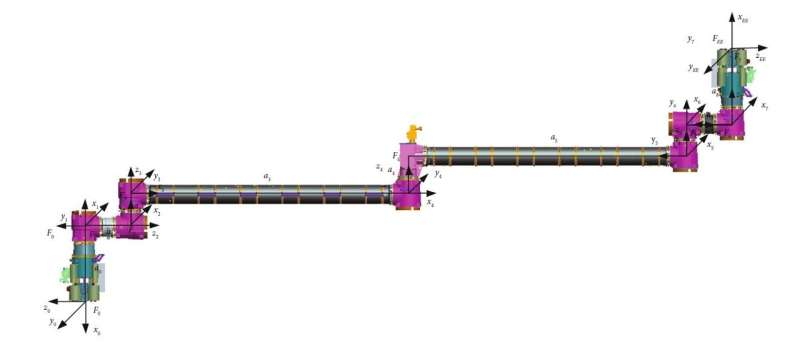How scientists designed the controllers for robot manipulators on the Chinese space station

In the process of the construction and routine maintenance of the Chinese Space Station, the manipulator plays a significantly important role that can accomplish some key tasks, such as transposition docking, daily maintenance, and auxiliary extravehicular activities. The high accuracy and dynamic performance of the manipulator are necessar for the successful completion of these tasks, which can often be maintained by controls that are designed based on the dynamics model.
However, in the practice situations, it is usually unrealistic to obtain all the inertia parameters precisely. Therefore, the adaptive control is developed to ensure the convergence of tracking control even if the system has uncertain or slowly changing parameters. In a research paper recently published in Space: Science & Technology, Dr. Li from the State Key Laboratory of Management and Control for Complex Systems, proposed a new recursive implementation of composite adaptive control for robot manipulators.
First, Dr. Li revisited the composite adaptive controller proposed by Slotine and Li. Adaptive control can ensure the convergence of tracking control even if the system has uncertain or slowly changing parameters. In general, this scheme can be divided into two classes named the direct adaptation and the indirect adaptation according to the signal that drives the parameter update law.
In the first category, the parameter update is driven by the tracking errors, while in the second category, the parameters are modified according to the prediction errors, usually of the filtered joint torques. Adaptive control based on tracking errors usually can guarantee a global tracking convergence; however, the converge of estimated parameters has more stringent conditions. In comparison, the indirect adaptive control has a faster parameter convergence speed, but it is generally difficult to obtain the stability of the tracking errors.
Combining the two methods, the well-known composite adaptive controller has the advantages of both, in which the parameter adaptation is driven by both tracking errors and prediction errors. However, computational complexity of these adaptive control methods is a main limitation in the practical robot manipulators, particularly for the case with high degree of freedom. Up to now, only a few works paid attention to the recursive execution of the indirect adaptive or the composite adaptive controller, probably because the use of the prediction error expressed by the regression matrix makes it very difficult to reduce the order of the computational complexity.
In order to solve the aforementioned difficulties, Dr. Li rewrote the Newton-Euler formulation by using the form of general matrices from the classic Recursive Newton-Euler Algorithm. Then, the recursive composite adaptive control method is designed and the stability of the proposed method is verified through selecting an appropriate Lyapunov function. The computational complexity of the proposed recursive composite adaptation is much less than that in the existing studies. The reason is that in the original composite controller, no consideration has been devoted to its computational aspects. Since the computational load of the proposed controllers is at the same scale as the recursive direct adaptive controllers, a comparison of between these two methods is conducted.
Results shows that the tracking errors are obviously decreased by using the recursive composite adaptive controller, and the parameter estimates converge faster with the recursive composite adaptive controller. In the simulation part, the manipulator of the Chinese Space Station is employed as a simulation example, and the results verify the effectiveness of the proposed recursive algorithm. Moreover, since the computational load is linear with the numbers of the joints, the proposed method is attractive especially for the redundant multijoint manipulator.
Jianfei Li et al, A New Recursive Composite Adaptive Controller for Robot Manipulators, Space: Science & Technology (2021). DOI: 10.34133/2021/9801421
Provided by
Beijing Institute of Technology Press
Citation:
How scientists designed the controllers for robot manipulators on the Chinese space station (2022, January 11)
retrieved 11 January 2022
from https://techxplore.com/news/2022-01-scientists-robot-chinese-space-station.html
This document is subject to copyright. Apart from any fair dealing for the purpose of private study or research, no
part may be reproduced without the written permission. The content is provided for information purposes only.
For all the latest Technology News Click Here
For the latest news and updates, follow us on Google News.
